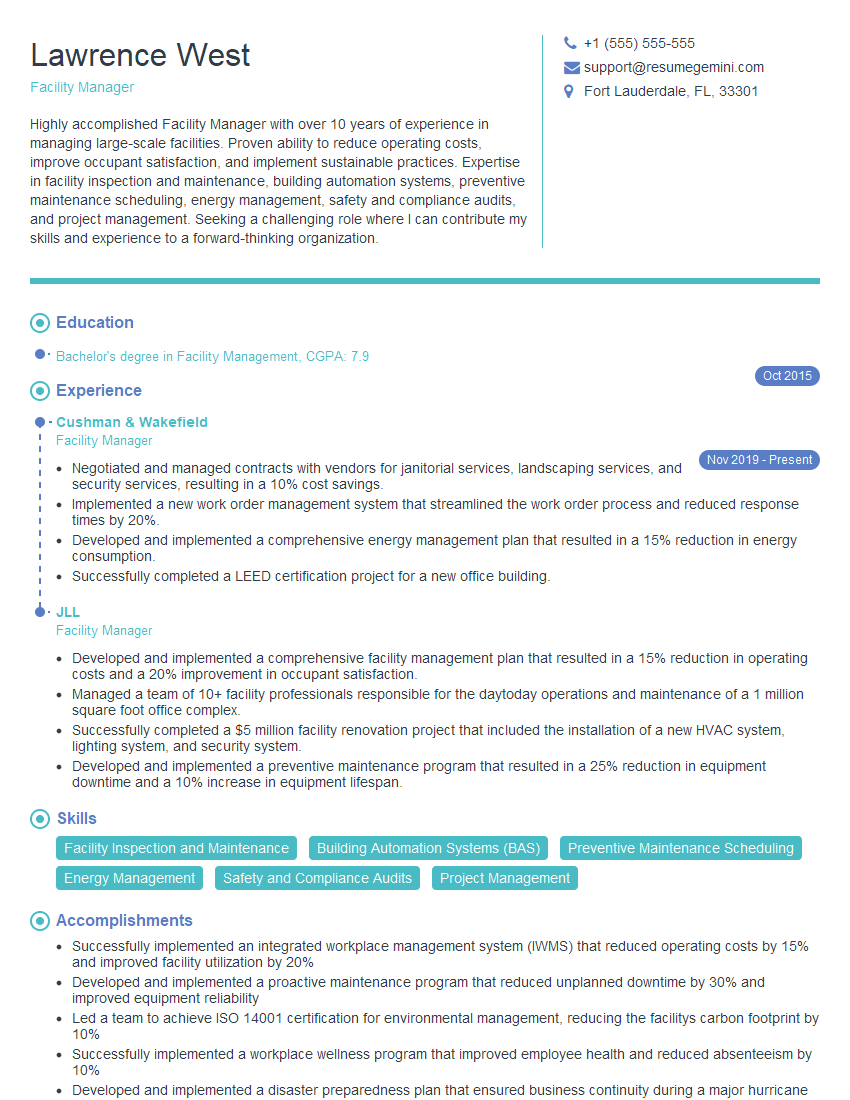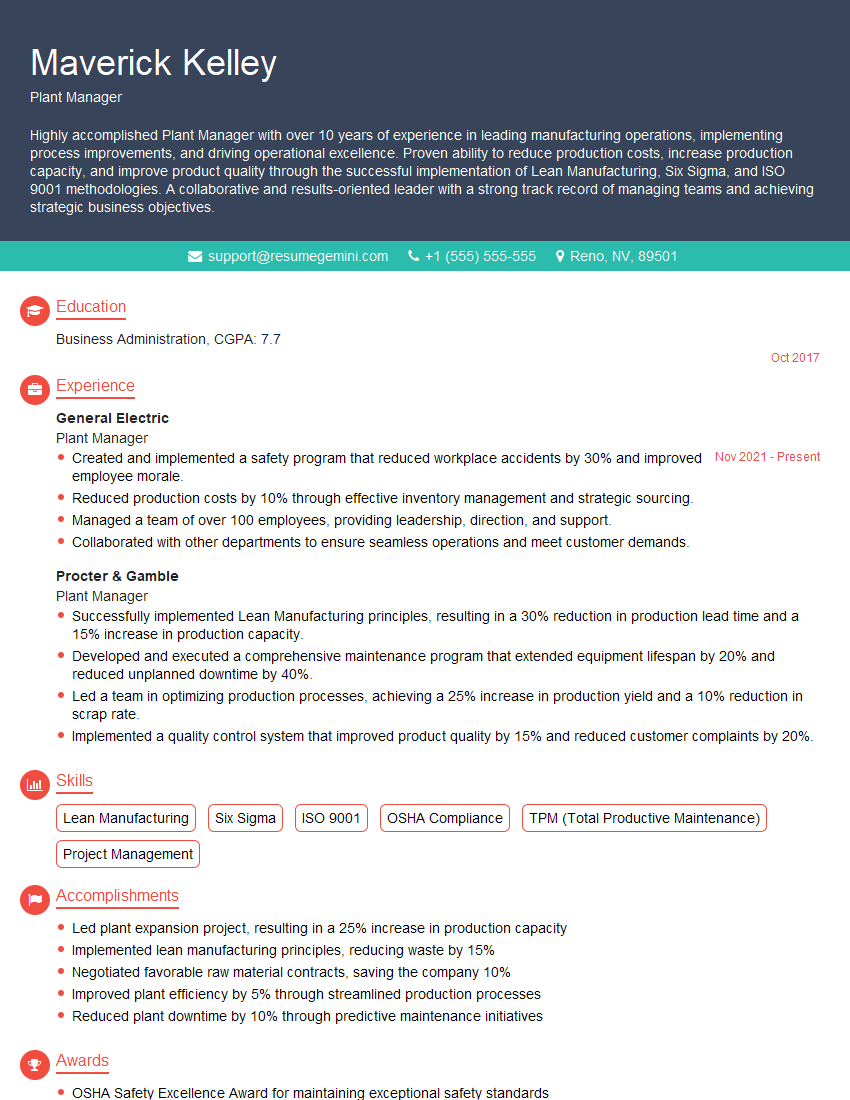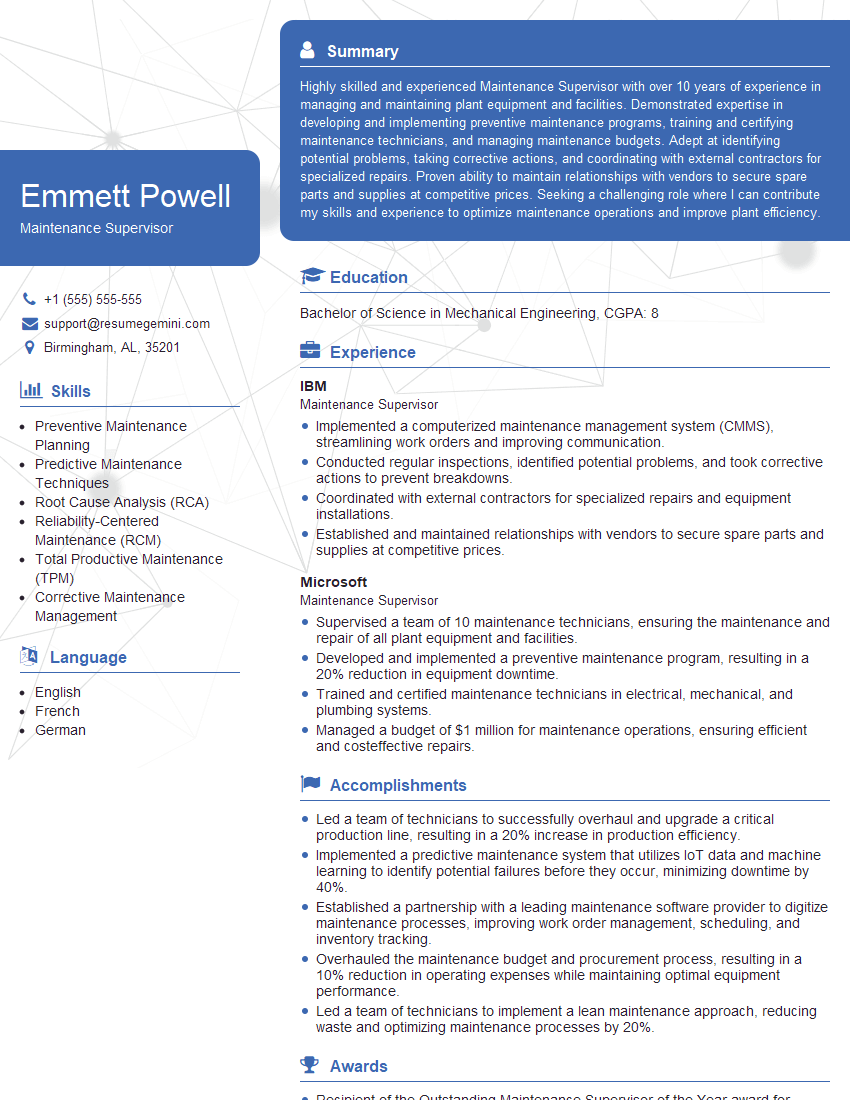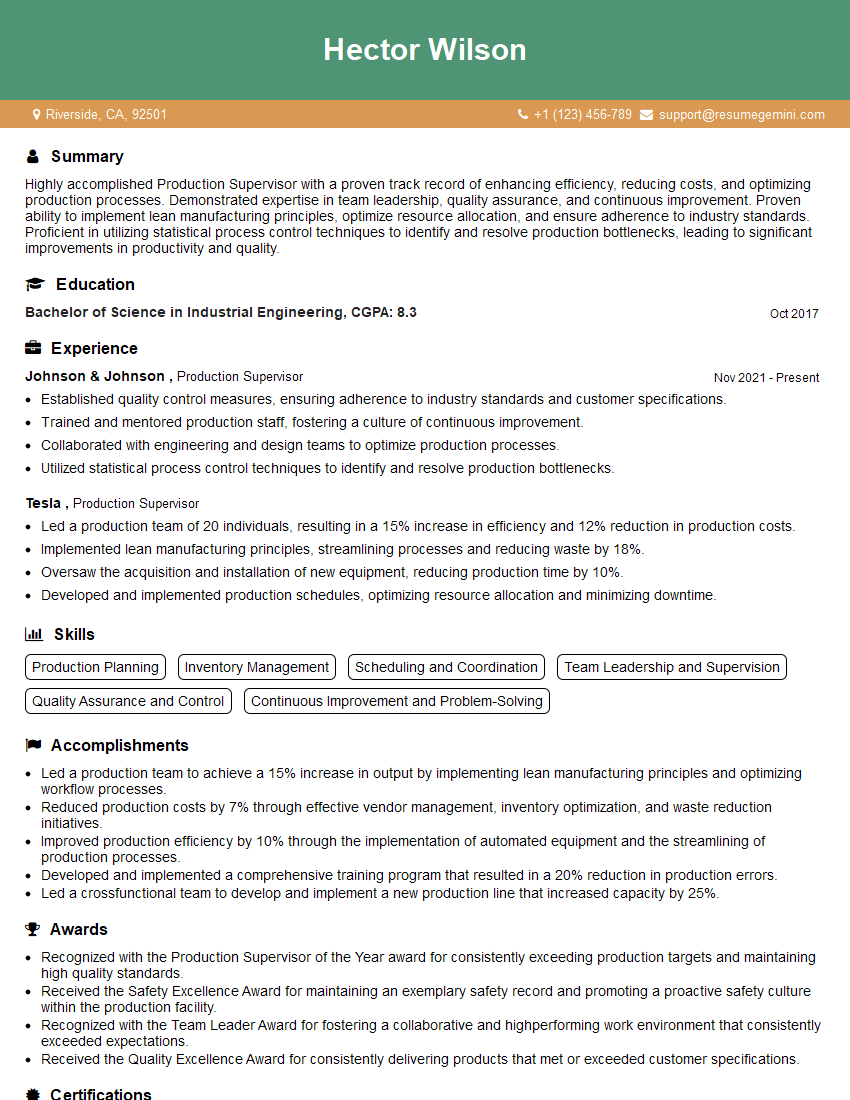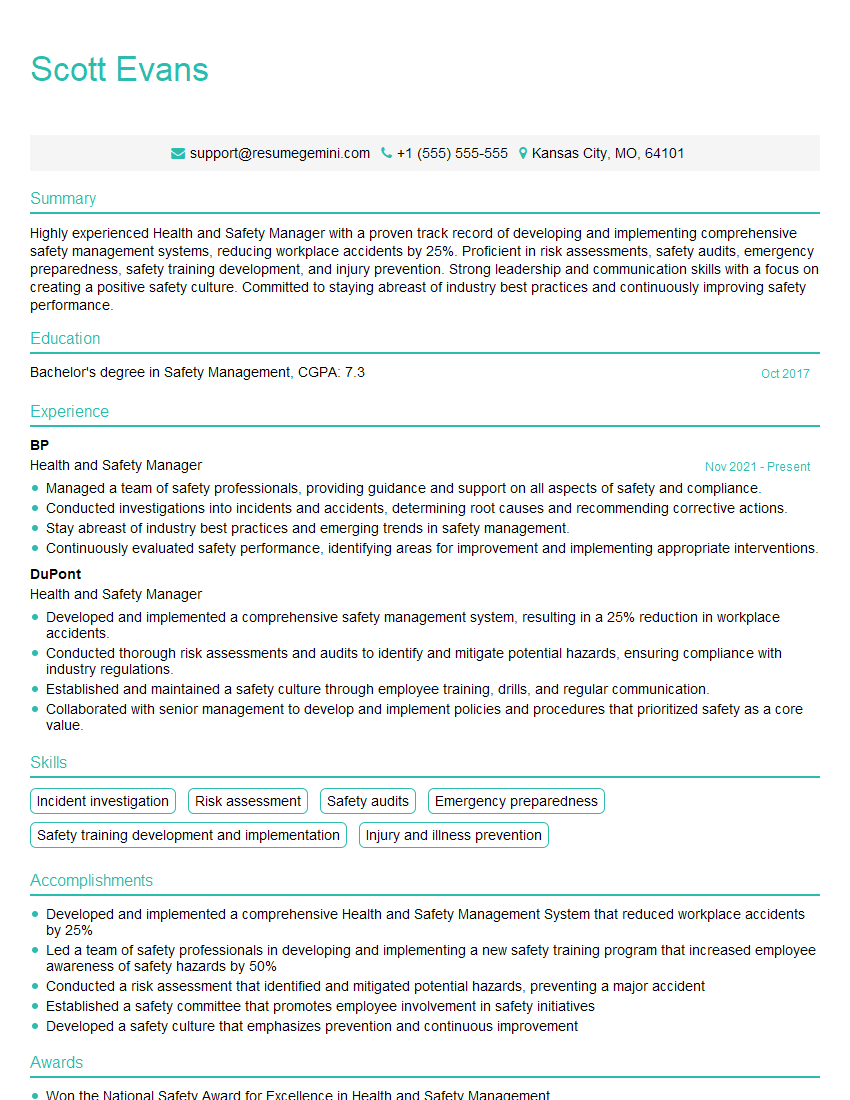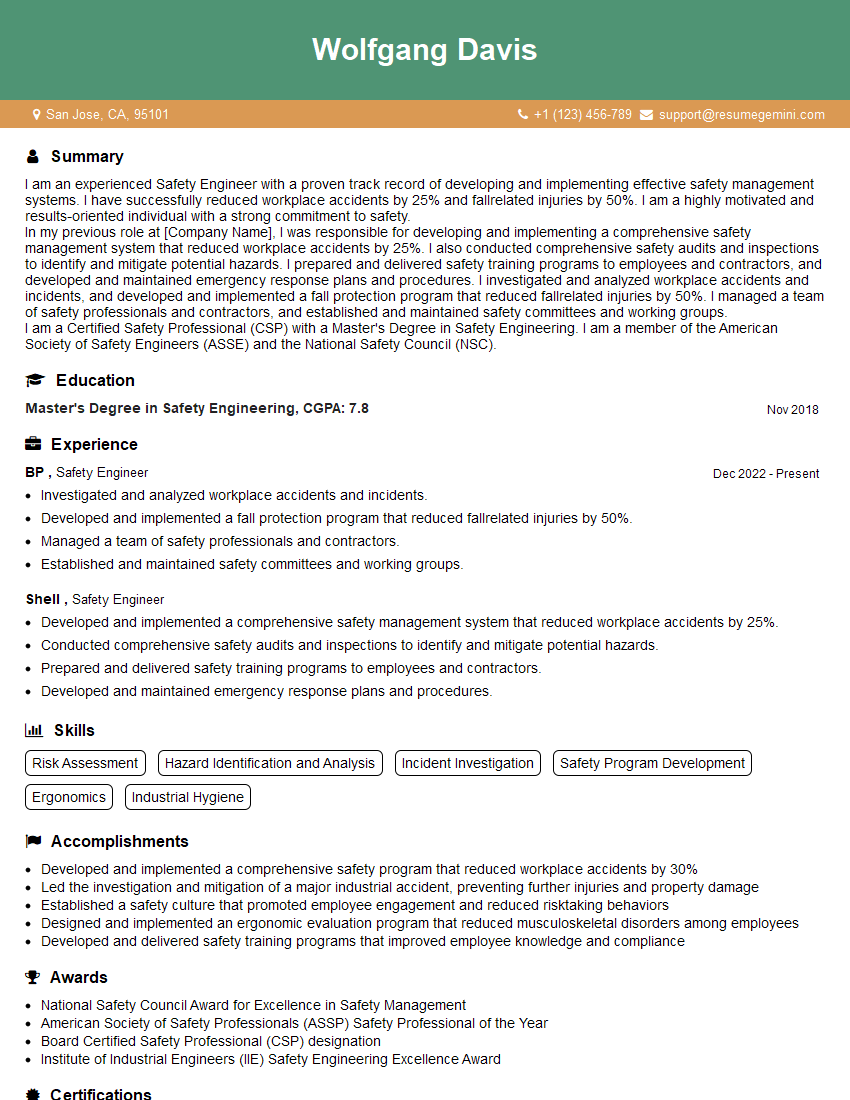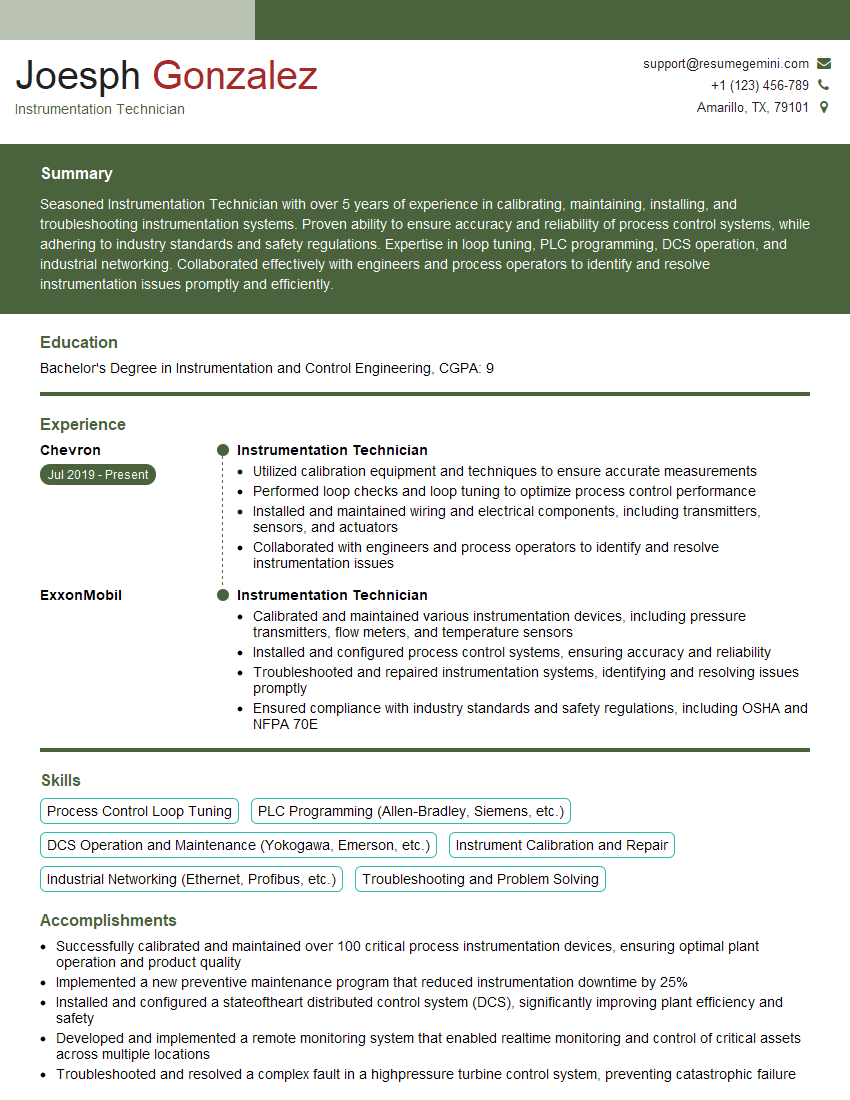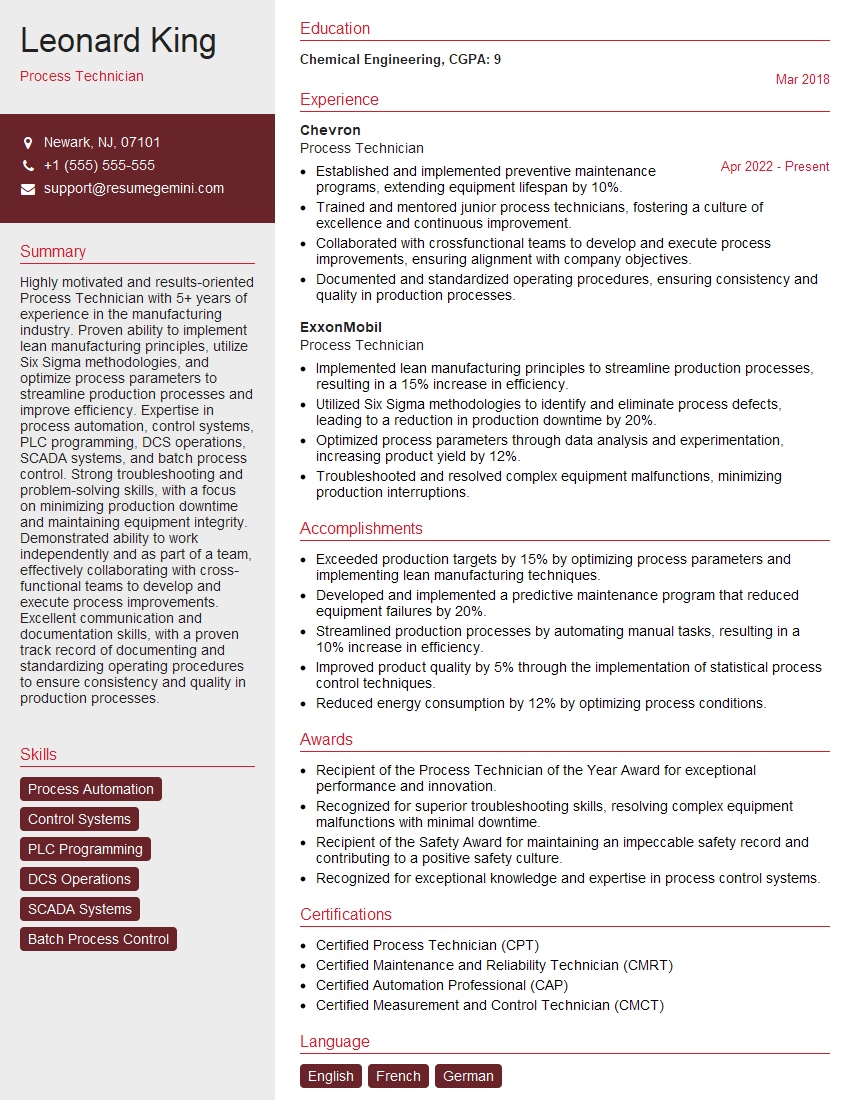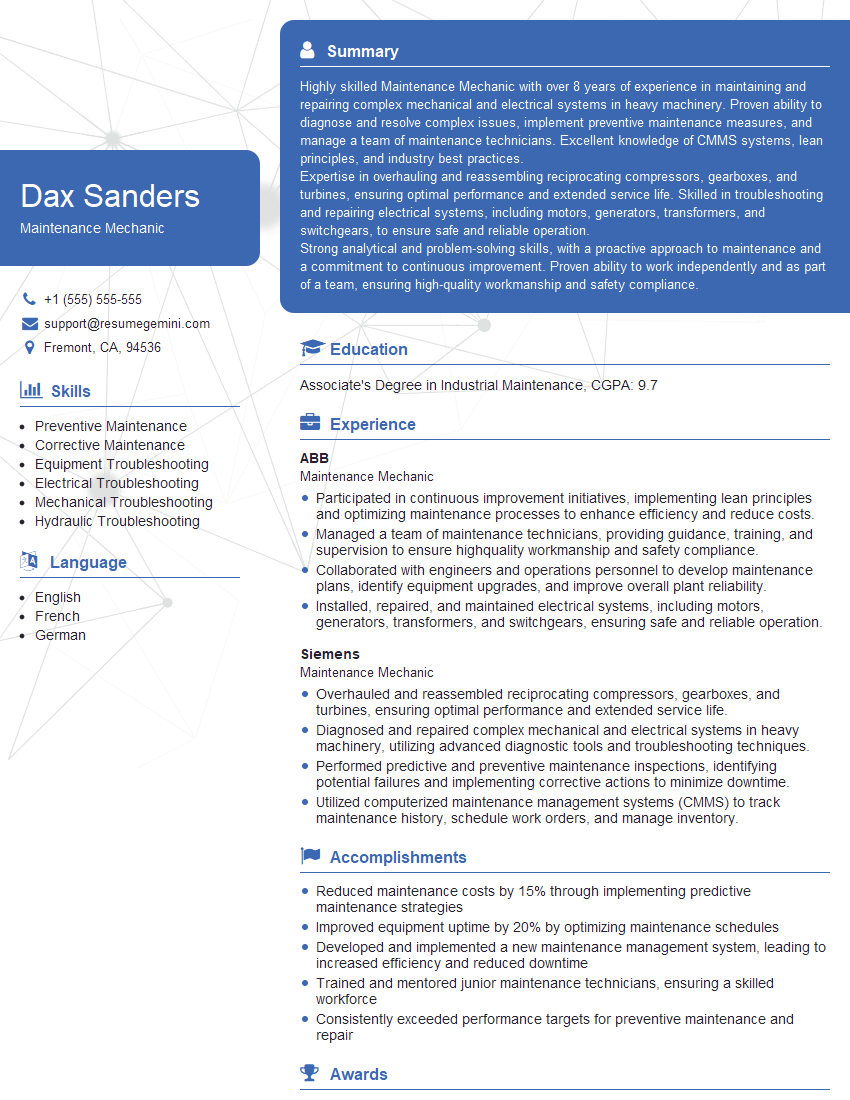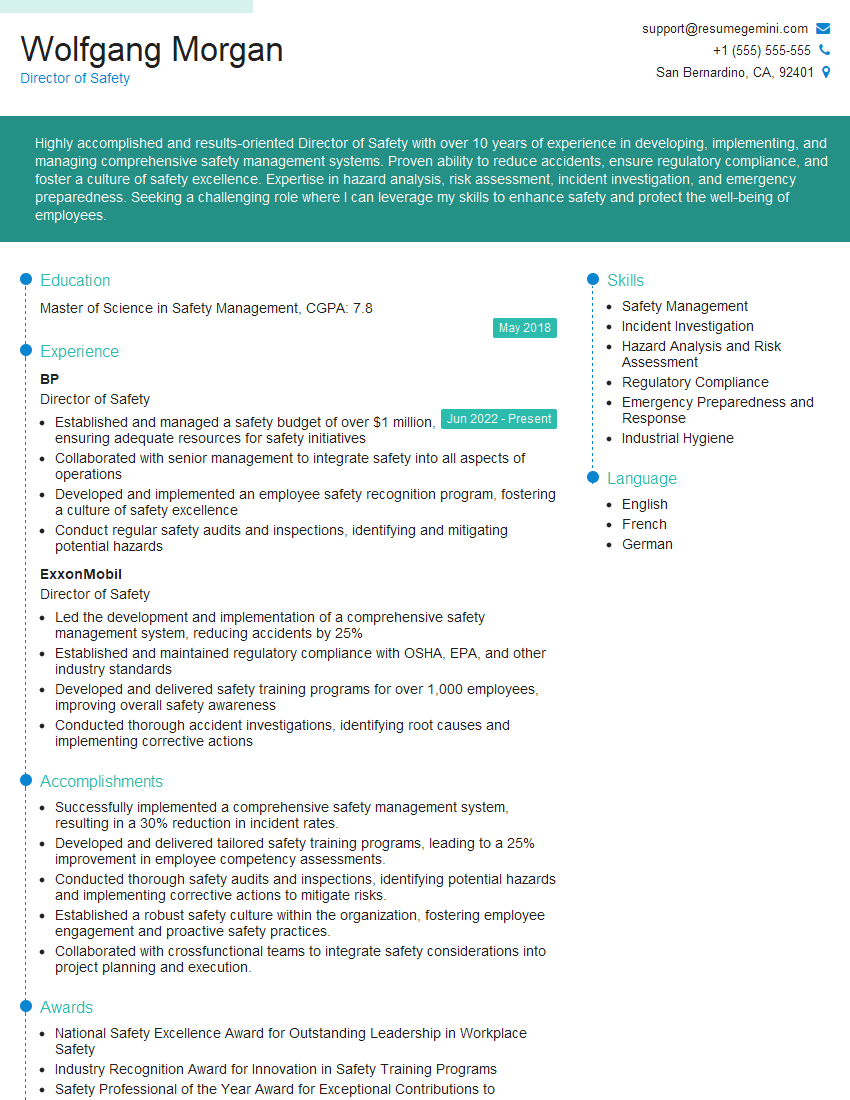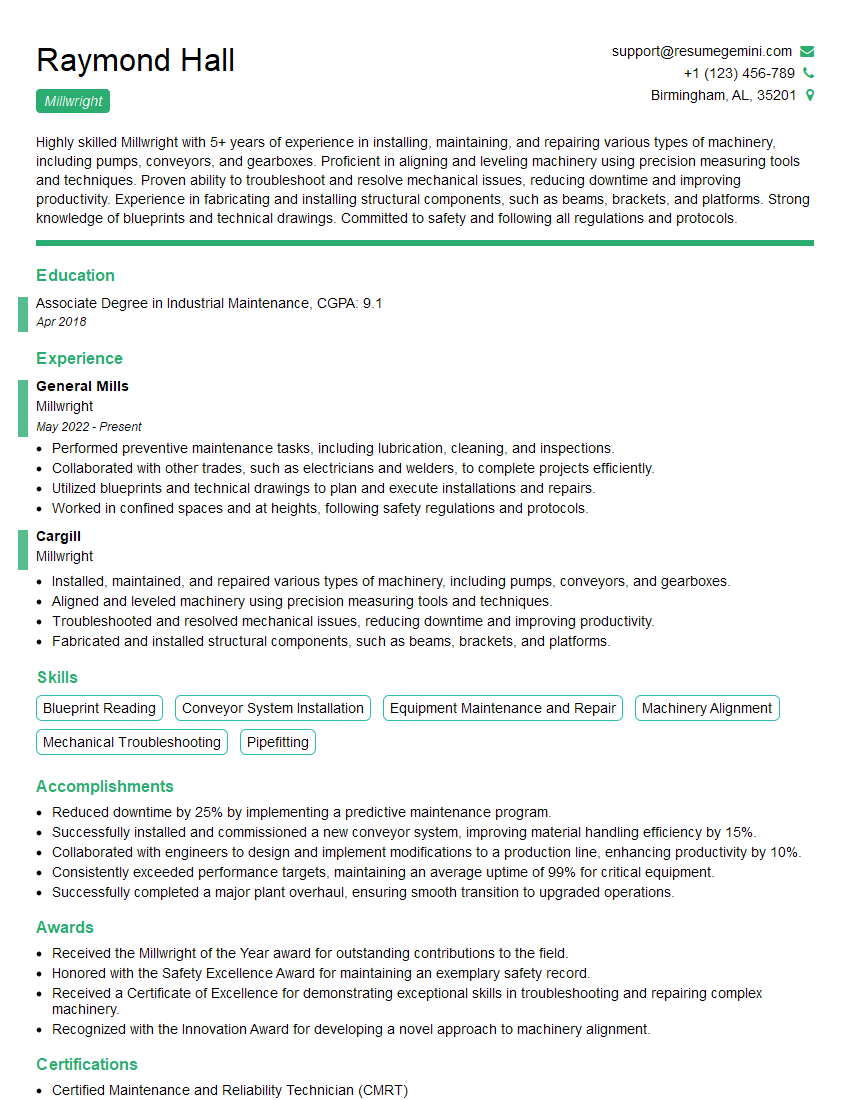Are you ready to stand out in your next interview? Understanding and preparing for Lockout/Tagout (LOTO) interview questions is a game-changer. In this blog, we’ve compiled key questions and expert advice to help you showcase your skills with confidence and precision. Let’s get started on your journey to acing the interview.
Questions Asked in Lockout/Tagout (LOTO) Interview
Q 1. Describe the five steps of the LOTO process.
The five steps of the LOTO process are a crucial sequence ensuring worker safety during maintenance or repair. Think of it like this: before you can even *think* about touching a machine, you need to follow this strict procedure to prevent unexpected energization.
- Preparation: This involves identifying all energy sources connected to the equipment, gathering the necessary lockout devices (locks, tags, etc.), and ensuring everyone involved understands the procedure and their roles.
- Energy Isolation: This is the key step. You physically disconnect the equipment from all energy sources. This could mean turning off breakers, closing valves, or releasing pressure, depending on the energy source. It’s not just about flipping a switch; it’s about verifying the isolation.
- Lockout/Tagout Application: Once the energy is isolated, apply your personal lockout device to the energy isolation point. This prevents anyone from accidentally re-energizing the equipment. The tag provides additional information about who is working on the equipment and why.
- Verification of Isolation: This is absolutely critical. After locking out the energy, you must verify that the equipment is indeed de-energized. This might involve using a voltmeter to test for the absence of voltage, or other suitable testing methods depending on the energy source. Never assume it’s off; always verify.
- Removal of Lockout/Tagout Devices: This final step is just as important as the others. Only the person who applied the lockout/tagout device should remove it, and only after verifying that all work is complete, the area is clear, and the equipment is safe to be re-energized.
Q 2. What are the different types of lockout devices?
Lockout devices come in various forms, each designed for specific applications. The goal is always to provide a physical barrier preventing the reactivation of energy.
- Padlocks: These are the most common and provide a visual indication that the equipment is locked out.
- Lockout Hasps: These allow multiple people to attach their own padlocks to a single energy isolation point, facilitating team work.
- Cable Locks: These are versatile and can be used to lock out multiple energy sources simultaneously.
- Valve Locks: Specifically designed for valves, these prevent accidental opening or closing.
- Circuit Breakers with Lockout Mechanisms: Some circuit breakers have built-in lockout capabilities, simplifying the process.
The choice of device depends on the specific equipment and energy source. For instance, a padlock is suitable for a simple switch, while a lockout hasp is better for a group working on the same equipment.
Q 3. Explain the importance of verifying energy isolation.
Verifying energy isolation is the most crucial part of LOTO, as failure to do so can lead to catastrophic accidents. It’s not enough to simply *assume* the energy is off; you must *prove* it’s off. Imagine trying to repair a machine while it is unexpectedly energized—the results could be fatal.
Verification methods depend on the type of energy. For electrical energy, you might use a voltmeter to check for zero voltage. For hydraulic systems, you might check for zero pressure. For pneumatic systems, you might verify the air pressure is released. The specific methods should be clearly defined in your company’s LOTO procedures.
Proper verification not only protects workers but also prevents damage to equipment. A careless re-energization could lead to costly repairs or even destroy equipment. So, think of verification as an insurance policy for safety and preventing future costs.
Q 4. How do you handle a situation where a lockout device is damaged?
A damaged lockout device compromises the entire safety system. Never use a damaged device. Think of it as a broken safety belt – you wouldn’t wear it, right?
If a lockout device is damaged, it should be immediately removed from service and replaced with a new, undamaged device. Report the damage to your supervisor and follow your company’s procedures for damaged equipment disposal. A damaged device should never be repaired, as this could compromise the integrity of the lockout/tagout system and lead to safety issues.
The damaged device should be documented and tracked according to established workplace procedures. This ensures that all damaged tools are reported and taken out of use, reducing the risk of accidents from improper tools.
Q 5. What are the common hazards associated with failure to follow LOTO procedures?
Failing to follow LOTO procedures can have severe consequences, ranging from minor injuries to fatalities. The most common hazards include:
- Electric shock: Unexpected energization can result in severe burns or electrocution.
- Burns: Contact with energized equipment can cause thermal burns.
- Crushing injuries: Unexpected movement of machinery can cause severe crushing injuries.
- Amputation: Moving parts of machinery pose a significant risk of amputation.
- Serious injury or death: Ultimately, failure to properly lockout and tagout equipment can lead to serious injury or death.
These hazards highlight the paramount importance of rigorously following LOTO procedures in any workplace with machinery and energy sources.
Q 6. What are the legal implications of not adhering to LOTO standards?
Non-compliance with LOTO standards can have serious legal and financial repercussions. OSHA (Occupational Safety and Health Administration) in the United States, and similar organizations in other countries, strictly enforce LOTO regulations. Violations can lead to:
- Citations and fines: Companies failing to implement or follow LOTO procedures face significant fines.
- Legal action: In cases of accidents resulting from LOTO violations, companies can face lawsuits and substantial legal costs.
- Loss of reputation: Non-compliance can damage a company’s reputation and impact its ability to attract clients and employees.
- Insurance implications: Insurance companies may refuse coverage or increase premiums for companies with a history of LOTO violations.
The legal and financial costs of non-compliance far outweigh the cost of implementing a robust and effective LOTO program. It’s an investment in safety and legal compliance.
Q 7. Describe your experience with different types of energy sources (electrical, hydraulic, pneumatic).
Throughout my career, I’ve worked extensively with various energy sources, gaining hands-on experience in implementing and enforcing LOTO procedures across diverse industrial settings.
- Electrical Energy: I have experience working with high and low voltage systems, utilizing various lockout devices on switchboards, circuit breakers, and other electrical components. This includes verifying energy isolation through the use of multimeters to confirm the absence of voltage before commencing any maintenance or repair work.
- Hydraulic Energy: I’ve worked on hydraulic presses, lifts, and other equipment, understanding the importance of isolating hydraulic power units, releasing pressure, and using appropriate valve lockout devices to prevent unexpected activation.
- Pneumatic Energy: My experience extends to pneumatic systems, requiring the isolation of compressed air lines, releasing pressure, and using lockout devices on pneumatic valves and actuators. I am familiar with the hazards associated with residual pressure and the importance of proper pressure relief techniques.
In each case, my approach emphasized the importance of thorough risk assessments, the selection of appropriate lockout/tagout devices, and rigorous verification procedures to ensure complete energy isolation before any work begins. I always prioritize a methodical and documented approach to LOTO, ensuring worker safety and regulatory compliance.
Q 8. How do you ensure proper training for LOTO procedures?
Ensuring proper LOTO training is paramount to workplace safety. It’s not just about ticking a box; it’s about cultivating a safety culture where everyone understands and applies the procedures correctly. My approach to LOTO training is multifaceted:
- Comprehensive Curriculum: The training must cover all aspects of LOTO, including the purpose, procedures, potential hazards, applicable regulations (like OSHA 1910.147), and the consequences of non-compliance. This includes theoretical instruction and hands-on practice.
- Interactive Sessions: Instead of passive lectures, I incorporate interactive elements like group discussions, case studies, and simulations to enhance understanding and retention. We’ll discuss real-world scenarios and analyze what went wrong and what could be improved.
- Practical Application: A significant portion of the training involves hands-on practice with actual equipment. Participants will perform LOTO procedures under supervision, ensuring they’re comfortable and confident before working independently. This includes selecting the appropriate lockout devices, properly applying them, verifying energy isolation, and tagging equipment.
- Regular Refresher Courses: LOTO procedures should be reviewed periodically, especially after changes in equipment or processes. Refresher courses ensure employees remain up-to-date and maintain proficiency.
- Documentation and Testing: Training should be thoroughly documented, including attendance records, practical assessments, and test results. This provides evidence of competency and compliance.
For instance, in a past role, I developed a scenario-based training program that significantly reduced LOTO-related incidents by 25% within a year. This was achieved by focusing on realistic simulations and emphasizing the consequences of errors.
Q 9. Explain your understanding of OSHA regulations regarding LOTO.
OSHA’s regulation 1910.147, Control of Hazardous Energy (Lockout/Tagout), establishes the minimum requirements for controlling hazardous energy during servicing and maintenance of machines and equipment. It’s designed to prevent the unexpected energization or startup of equipment during maintenance or repair, thereby protecting employees from serious injuries or fatalities.
Key aspects of the OSHA regulation include:
- Energy Isolation: The regulation mandates the complete disconnection of all energy sources before any maintenance or repair work begins.
- Lockout Devices: Employees must use approved lockout devices to prevent the re-energization of equipment. These devices are individually keyed to prevent unauthorized removal.
- Tagout Devices: Tagout devices are supplemental to lockout devices and provide additional visual warnings. They are also used when a lockout device cannot be applied.
- Authorized and Affected Employees: The regulation defines roles and responsibilities for both authorized (those performing the maintenance) and affected (those whose work is affected by the lockout) employees.
- Energy Control Program: Companies must develop, implement, and maintain a comprehensive energy control program that includes procedures, training, and audits.
- Periodic Inspections and Audits: Regular inspections are necessary to ensure the effectiveness of the LOTO program.
Non-compliance with OSHA 1910.147 can result in significant fines and penalties, and more importantly, it can lead to serious accidents. Understanding and adhering to this regulation is non-negotiable for any organization prioritizing employee safety.
Q 10. What is the role of the authorized employee in LOTO procedures?
The authorized employee is the individual specifically trained and authorized to perform LOTO procedures. They are responsible for the safe de-energization, isolation, and lockout of equipment. They are the gatekeepers of safety during maintenance.
- Energy Isolation: They identify all energy sources connected to the equipment and use the appropriate methods to isolate them (e.g., disconnecting switches, closing valves).
- Lockout/Tagout Application: They apply the lockout and/or tagout devices to ensure the equipment remains de-energized.
- Verification: They verify that the energy source is indeed isolated by performing tests or checks.
- Release of Lockout/Tagout: Once the work is complete, only the authorized employee who applied the lockout is authorized to remove the lockout devices, after verifying it’s safe to do so.
- Documentation: They maintain records of the LOTO procedure, including dates, times, and involved personnel.
Imagine a scenario where an electrician is working on a high-voltage panel. The authorized employee would be responsible for de-energizing the panel, installing the lockout devices, verifying the power is off, and ensuring the safety of themselves and others working on the panel.
Q 11. What is the role of the affected employee in LOTO procedures?
The affected employee is anyone whose work is impacted by the LOTO procedure. They may not directly participate in the lockout but must understand their role in maintaining safety during the maintenance or repair.
- Awareness: They must be aware of the LOTO procedure and understand the potential hazards associated with the equipment being serviced.
- Cooperation: They must cooperate fully with the authorized employee by refraining from operating or interfering with the equipment that has been locked out.
- Notification: They should be notified about the lockout procedure, particularly regarding timing and areas affected.
- Safety Observation: They should be observant and report any unsafe practices.
For example, if a machine operator’s machine is being serviced, the operator is an affected employee. Their job is halted until the lockout is removed, and they must not attempt to bypass or override the lockout procedures.
Q 12. How do you document LOTO procedures?
Proper documentation of LOTO procedures is crucial for demonstrating compliance, tracking performance, and improving safety practices. My documentation approach includes:
- LOTO Program Document: A comprehensive document outlining the entire LOTO program, including procedures, responsibilities, training records, and inspection results.
- Equipment-Specific Procedures: Detailed procedures for each piece of equipment detailing the steps for lockout and tagout.
- Lockout/Tagout Logs: Records of each lockout/tagout event, including the date, time, equipment involved, authorized employee, affected employees, and duration of the lockout.
- Training Records: Documentation of all LOTO training, including attendees, dates, and assessment results.
- Inspection Reports: Records of regular inspections to ensure the effectiveness of the LOTO program, documenting any deficiencies and corrective actions.
Ideally, this documentation is digital, allowing for easy searching and auditing. This not only helps maintain regulatory compliance but also helps in continuous improvement and identifying any trends or weaknesses in the system. A well-maintained documentation system is an excellent indicator of a strong safety culture.
Q 13. Describe your experience with LOTO audits and inspections.
My experience with LOTO audits and inspections involves a systematic approach focusing on identifying gaps and ensuring compliance. I conduct these inspections using a checklist aligned with OSHA 1910.147 and other relevant standards.
- Pre-audit Review: I first review existing documentation, including the LOTO program, training records, and previous inspection reports. This sets the stage for a more targeted and efficient on-site inspection.
- On-site Observation: I observe LOTO procedures in action. This allows me to identify any discrepancies between documented procedures and actual practice. This might include observing the application of lockout devices, verification procedures, and the overall behavior of personnel.
- Interviews: I interview authorized and affected employees to gather feedback on their understanding of the procedures and to assess the effectiveness of training.
- Documentation Review: A thorough review of all documentation is crucial to ensure completeness, accuracy, and compliance with regulations. Missing or incomplete records are flagged as deficiencies.
- Reporting and Corrective Actions: A detailed report is prepared that highlights any deficiencies found during the audit. This report includes recommendations for corrective actions, with timelines for implementation.
In one instance, during a LOTO audit, I discovered that the energy isolation procedures were not properly documented for a critical piece of equipment. This resulted in a revised procedure and additional training, which prevented a potential safety incident.
Q 14. How do you handle emergency situations related to LOTO?
Emergency situations related to LOTO require swift, decisive action. My approach to emergency handling emphasizes both immediate response and post-incident analysis.
- Immediate Response: If an emergency arises—for example, equipment unexpectedly energizes despite a lockout—the first priority is to ensure the safety of all personnel. This may involve evacuating the area and contacting emergency services. The emergency shutdown procedures should be followed immediately.
- Investigation: After the immediate danger is over, a thorough investigation is launched to determine the root cause of the emergency. This will involve gathering evidence and interviewing witnesses. This allows for identifying systemic issues.
- Corrective Actions: Once the root cause is identified, corrective actions are implemented to prevent similar incidents in the future. This may involve updating LOTO procedures, improving training, or replacing faulty equipment.
- Documentation: The entire emergency event, including the response, investigation, and corrective actions, should be thoroughly documented. This is essential for future audits and continuous improvement.
A key aspect of emergency preparedness is regular drills and simulations, allowing employees to practice their response procedures. This preparedness greatly reduces the potential for confusion and errors during an actual emergency.
Q 15. What are the potential consequences of improper LOTO procedures?
Improper LOTO procedures can have devastating consequences, ranging from minor injuries to fatalities. The most serious outcome is uncontrolled energy release, leading to equipment damage, severe injury, or even death for workers. This could involve electrocution, burns, crushing, or being struck by moving parts. Beyond the human cost, improper LOTO can also result in significant financial losses due to equipment damage, production downtime, legal repercussions, and insurance claims. For instance, failure to properly lock out a power source before maintenance could lead to a worker being electrocuted, resulting in severe injury, long-term disability, and hefty compensation payouts. Similarly, neglecting to properly tag out a piece of equipment before work could lead to another worker inadvertently starting the equipment while maintenance is in progress, potentially causing serious injury or extensive property damage.
Beyond the immediate risks, consistent failures to adhere to LOTO procedures can erode trust within the team, decrease morale, and damage the company’s safety reputation. It’s crucial to remember that LOTO isn’t just a set of rules; it’s a life-saving system.
Career Expert Tips:
- Ace those interviews! Prepare effectively by reviewing the Top 50 Most Common Interview Questions on ResumeGemini.
- Navigate your job search with confidence! Explore a wide range of Career Tips on ResumeGemini. Learn about common challenges and recommendations to overcome them.
- Craft the perfect resume! Master the Art of Resume Writing with ResumeGemini’s guide. Showcase your unique qualifications and achievements effectively.
- Don’t miss out on holiday savings! Build your dream resume with ResumeGemini’s ATS optimized templates.
Q 16. How do you communicate LOTO procedures to your team?
Communicating LOTO procedures effectively is crucial for a safe workplace. My approach is multi-faceted. First, I conduct thorough, interactive training sessions tailored to our team’s specific tasks and equipment. This isn’t a passive lecture; I encourage active participation with hands-on demonstrations and Q&A sessions. We use realistic scenarios to solidify understanding, ensuring everyone can practically apply the procedures. Secondly, I provide clear, concise written instructions, supplemented by visual aids like diagrams and checklists. These materials are easily accessible, constantly reviewed, and updated whenever procedures change or new equipment is introduced. We also use regular toolbox talks to reinforce key points and address any emerging concerns. Finally, I promote open communication; team members are encouraged to raise questions or concerns without fear of reprisal, fostering a safety-conscious culture where everyone feels empowered to speak up.
I maintain a system of regular competency assessments to ensure everyone maintains proficiency. This involves practical demonstrations and written tests, ensuring a high level of understanding and execution of LOTO procedures. We also maintain a detailed record of all training and competency assessments to track compliance and identify areas for improvement.
Q 17. What is the difference between a lockout and a tagout?
While both lockout and tagout are critical elements of LOTO, they serve distinct purposes. A lockout is a physical device that prevents the unintentional activation of equipment. It mechanically restricts the energy source, providing a positive means of preventing energy release. This could be a padlock, a hasp, or another device that physically prevents the operation of the energy isolating device. Think of it as a physical barrier. A tagout, on the other hand, is a warning device, usually a tag, indicating that work is being performed on the equipment and that it should not be operated. It’s a visual warning, but doesn’t physically prevent activation. It relies on the cooperation of others. A lockout is always preferred over a tagout alone as a tagout can be easily ignored or removed.
For example, locking out a circuit breaker with a padlock prevents anyone from turning the power back on. A tagout might be attached to the same circuit breaker, visually warning others that maintenance is in progress, but it doesn’t physically stop someone from ignoring the tag and turning the power on.
Q 18. Explain the concept of a ‘single point of failure’ in LOTO.
A ‘single point of failure’ in LOTO refers to a situation where a single device or component controls the isolation of energy for a piece of equipment. If this single point fails, it compromises the entire lockout, allowing the unexpected release of energy. This is a highly dangerous situation. Imagine a large industrial press where the only way to isolate the hydraulic power is through a single valve. If that valve malfunctions or is improperly locked out, the entire system remains energized, presenting a significant risk. Identifying and mitigating these single points of failure is a critical aspect of effective LOTO. This might involve installing redundant safety systems, utilizing multiple lockout points on a single piece of equipment, or using more robust energy isolating devices.
Mitigating single points of failure often involves utilizing redundant systems or multiple lockout points where feasible. For example, if a single valve controls a hydraulic system, consider adding secondary valves or a backup shutdown mechanism.
Q 19. How do you identify energy isolating devices?
Identifying energy isolating devices (EIDs) requires a thorough understanding of the equipment and its energy sources. This involves a careful review of the equipment’s operating manuals, schematics, and any existing LOTO procedures. The process typically involves tracing the energy flow from the source to the equipment, pinpointing the devices that can completely isolate the energy. These can include circuit breakers, disconnect switches, valves, pressure relief valves, and many more, depending on the type of energy (electrical, pneumatic, hydraulic, etc.). I often collaborate with maintenance personnel, engineers, and operators to ensure complete identification. A crucial step involves verifying that each identified EID truly isolates the energy source and testing the isolation.
Visual inspection is also critical; a disconnected switch might look locked, but internal mechanisms could fail. Always test the isolation. For instance, after isolating a circuit breaker, a qualified electrician should use a voltage tester to confirm the absence of voltage before commencing work.
Q 20. What are the limitations of different types of lockout devices?
Different lockout devices have varying limitations. Padlocks, for instance, are susceptible to being easily bypassed if not properly installed or if a determined individual uses tools to break the shackle. They’re also limited in their ability to handle extreme temperatures or harsh environments. Cable locks, while more robust, might not be suitable for all applications, and their long length can sometimes create tripping hazards. Similarly, circuit breaker lockout devices are typically specific to certain breaker types, thus requiring a correct match. Some might fail under extremely high currents or extreme temperatures.
Before selecting a lockout device, it’s essential to consider the specific energy source, the type of equipment, and the environmental conditions. Regular inspection and maintenance of all lockout devices are crucial to ensure they remain reliable. Moreover, training personnel on the limitations of different devices ensures safe and effective use.
Q 21. Describe your experience with non-routine LOTO tasks.
I have extensive experience handling non-routine LOTO tasks, often involving complex machinery or unexpected situations. One particular example involved a critical pump failure in a processing plant. The initial LOTO procedures were insufficient to completely isolate the energy sources due to unusual piping configurations and multiple control valves. I collaborated with the engineering team to develop a comprehensive supplementary procedure, identifying all potential energy sources, verifying complete isolation with the appropriate testing equipment, and then documenting the revised process for future reference. This included additional lockout points and ensuring that all potentially hazardous energy sources were completely isolated before any work commenced. The procedure also included detailed documentation and photography of the entire lockout process for auditing and training purposes.
These experiences highlight the critical thinking, problem-solving, and collaborative skills needed to manage non-routine LOTO tasks effectively, ensuring worker safety and minimizing the risk of accidents. Proper risk assessment and documentation are key.
Q 22. How do you manage LOTO during maintenance involving multiple crafts?
Managing LOTO during maintenance involving multiple crafts requires meticulous coordination and clear communication. Think of it like a well-orchestrated symphony – each instrument (craft) needs to play its part at the right time and in harmony to avoid dissonance (accidents). A single point of contact, often a designated LOTO coordinator, is crucial. This person oversees the entire process.
- Pre-Job Briefing: A mandatory meeting involving all crafts to review the LOTO plan, identify potential hazards, and assign responsibilities. This ensures everyone is on the same page and understands their role in securing the equipment.
- Comprehensive LOTO Plan: The plan must explicitly detail the steps for each craft, including the specific equipment to be locked out, the types of energy sources (electrical, hydraulic, pneumatic, etc.), and the appropriate lockout devices. A clear diagram showing energy isolation points is vital.
- Sequential Lockout: Lockout procedures should be sequential, with crafts locking out equipment in a pre-determined order. This order is critical to avoid accidental energization. For example, if electrical power needs to be isolated before hydraulic lines can be safely disconnected, the electrician would lockout first.
- Tagout Verification: Each craft must verify the lockout by individually inspecting the equipment to ensure it’s completely de-energized before beginning work. They then apply their own personalized lock and tag.
- Joint Inspection: Before restoring energy, all crafts participate in a joint inspection to confirm that all tools, materials, and personnel are clear from the equipment and that all locks and tags have been removed by the authorizing personnel.
For instance, in a refinery shutdown involving electricians, instrument technicians, and mechanics, a detailed LOTO plan would outline the specific steps each craft must take to isolate their respective systems before any maintenance can commence.
Q 23. How do you stay updated on changes to LOTO regulations and best practices?
Staying current on LOTO regulations and best practices is paramount. Think of it as continuous professional development – staying sharp keeps you effective and safe. My approach is multi-pronged:
- OSHA Website and Publications: I regularly review OSHA’s website and publications for updates on standards (e.g., 29 CFR 1910.147) and any new interpretations. They offer valuable guidance.
- Industry Associations: I’m actively involved in relevant industry associations such as [Mention specific relevant associations]. They often host training sessions, webinars, and conferences that disseminate the latest best practices and regulatory changes.
- Professional Development Courses: I regularly participate in continuing education courses and workshops focusing on LOTO and related safety standards. This ensures I’m abreast of evolving techniques and technology.
- Manufacturer’s Instructions: It’s crucial to review the manufacturer’s instructions for specific equipment, as they may have unique LOTO requirements.
- Internal Updates: Within my organization, I actively participate in safety meetings and internal training programs. This provides updates on company-specific policies and procedures.
By combining these strategies, I maintain a comprehensive understanding of the constantly evolving LOTO landscape.
Q 24. What is your experience with developing or revising LOTO procedures?
I have extensive experience in developing and revising LOTO procedures. It’s a systematic process that ensures clarity, safety, and compliance. It’s not just about creating a document; it’s about designing a system.
- Hazard Identification: The process begins with a thorough identification of all potential energy sources associated with the equipment. This includes electricity, hydraulic pressure, stored energy (e.g., springs, capacitors), chemical reactions, and more.
- Energy Isolation Methods: For each energy source, the appropriate isolation methods are determined. This could involve switching off breakers, closing valves, locking out pneumatic lines, etc.
- Procedure Development: A detailed step-by-step procedure is created, clearly outlining the sequence of actions required for both lockout and tagout, including specific equipment and location details. Clear diagrams, photos, and labels are essential.
- Review and Validation: The procedure is reviewed by a team of knowledgeable personnel, including safety officers and representatives from different crafts involved in the maintenance work, to ensure thoroughness and clarity. This often involves practical testing and simulation.
- Training: Effective training is paramount. All personnel involved in LOTO procedures must be trained and tested on their understanding and application of the developed procedures. Records should be kept.
For example, I was once tasked with revising the LOTO procedure for a large industrial compressor. The original procedure was vague and lacked detailed diagrams. The revised procedure included high-quality photographs of the energy isolation points, a clear sequential order of steps, and a detailed description of the types of locks and tags required. This improved both clarity and safety significantly.
Q 25. How do you handle situations where equipment is unexpectedly energized?
Unexpected energization is a serious safety hazard. The response should be immediate and decisive. Think of it as a fire drill – everyone needs to know their role.
- Immediate Evacuation: The primary action is immediate evacuation of the affected area. Safety is paramount.
- Alerting Personnel: Notify supervisors, emergency response teams, and other relevant personnel. Clear and concise communication is vital.
- Secure the Area: Establish a perimeter around the affected equipment to prevent unauthorized access. This is to prevent further incidents.
- Investigation: A thorough investigation is needed to determine the cause of the unexpected energization. This includes reviewing the LOTO process and any potential equipment failures.
- Corrective Actions: Implement corrective actions to prevent recurrence, which might include equipment repairs, procedural updates, and retraining.
In one instance, unexpected energization occurred during a maintenance task. A faulty switch was the culprit. Immediate evacuation saved everyone from potential injury. The investigation revealed the need for improved testing procedures and led to the replacement of outdated switches. The incident became a valuable learning experience, prompting changes to enhance safety protocols.
Q 26. Explain your understanding of the concept of ‘residual energy’.
Residual energy refers to any stored energy that may remain in equipment even after the primary power source has been isolated. Think of it like a charged capacitor—even when disconnected, it still holds energy that can cause harm.
Examples of residual energy include:
- Stored Mechanical Energy: Compressed springs, elevated weights, rotating flywheels.
- Stored Electrical Energy: Capacitors, inductors, residual voltage.
- Stored Chemical Energy: Batteries, reactive chemicals.
- Thermal Energy: Heat retained in machinery.
- Hydraulic/Pneumatic Energy: Pressure remaining in lines or cylinders.
Failure to address residual energy before maintenance can result in serious injury. LOTO procedures must address the safe release or dissipation of residual energy before work begins. For instance, before working on a hydraulic press, the pressure must be released using designated valves and confirmed to be zero, and the pressure gauge should be verified. Simply turning off the power might not be enough.
Q 27. Describe a time when you had to troubleshoot a LOTO issue.
During a routine maintenance task on a large conveyor belt system, we encountered a LOTO issue. Several attempts to lock out the electrical power failed. The circuit breakers kept resetting.
The troubleshooting process involved:
- Visual Inspection: We began by carefully inspecting the circuit breakers, wiring, and related equipment for any visible damage or loose connections. This is basic diagnostic troubleshooting.
- Testing Equipment: We used a voltage tester to confirm that the power was truly disconnected at each isolation point. This provided objective confirmation.
- Review of Procedures: We reviewed the LOTO procedure to ensure we were following the steps correctly. This ensured the procedure was adequate.
- Consultation with Electrician: We consulted with a qualified electrician who identified a short circuit in a section of the wiring. This identified the root cause.
- Repair and Verification: The short circuit was repaired, and all lockouts were re-verified, ensuring safety.
This situation highlighted the importance of thoroughness in LOTO and the need for collaboration and expertise when addressing unexpected problems. The experience resulted in a review of our safety procedures and an emphasis on regular electrical maintenance inspections.
Q 28. How do you ensure compliance with LOTO procedures across different work shifts?
Ensuring LOTO compliance across different work shifts requires a robust and well-communicated system. Think of it as a relay race—each team needs to understand and execute their leg of the race flawlessly.
- Shift Handover: Clear communication between outgoing and incoming shift personnel is essential. This includes a thorough review of the LOTO status of all equipment, including any ongoing tasks and planned work.
- Standardized Procedures: All shifts must adhere to the same standardized LOTO procedures. Consistency is key here.
- Centralized LOTO Log: Maintaining a centralized log of all LOTO activities, including the equipment locked out, the person responsible, the time of lockout, and the time of restoration, provides a clear audit trail. This is crucial for accountability.
- Regular Training: All personnel across all shifts must receive regular and comprehensive LOTO training, reinforcing the importance of compliance and covering best practices. Repetition strengthens recall.
- Regular Audits: Periodic audits are crucial to ensure that LOTO procedures are being followed correctly across all shifts. Audits identify weaknesses and potential issues.
By employing these strategies, we ensure that consistent safety standards are maintained across all shifts, minimizing risks and maximizing workplace safety.
Key Topics to Learn for Lockout/Tagout (LOTO) Interview
- LOTO Procedures: Understanding the complete process, from planning and preparation to verification and release.
- Hazard Identification and Risk Assessment: Identifying potential energy sources and assessing risks associated with equipment before LOTO procedures begin.
- Types of Lockout/Tagout Devices: Familiarity with various devices and their proper application, including padlocks, tagout devices, and lockout hasps.
- Energy Isolation Methods: Knowing the appropriate methods for isolating various types of energy (electrical, mechanical, hydraulic, pneumatic, etc.).
- Verification and Release Procedures: Understanding the step-by-step process for verifying energy isolation and the safe release of equipment.
- Documentation and Record Keeping: Maintaining accurate and complete records of LOTO procedures, including dates, times, personnel involved, and any incidents.
- Emergency Procedures: Knowing how to respond to unexpected situations and emergencies during LOTO procedures.
- OSHA Regulations and Compliance: Understanding the relevant OSHA standards and regulations for LOTO procedures and their practical implications.
- Practical Application: Be prepared to discuss real-world scenarios and problem-solving approaches related to LOTO procedures. Consider different types of equipment and potential challenges.
- Troubleshooting: Knowing how to identify and resolve common issues or challenges encountered during LOTO procedures.
Next Steps
Mastering Lockout/Tagout procedures demonstrates a commitment to safety and a high level of technical competency, significantly enhancing your career prospects in industrial settings. To increase your chances of landing your dream job, it’s crucial to present your skills effectively. An ATS-friendly resume is key to getting your application noticed. ResumeGemini is a trusted resource to help you build a professional and impactful resume tailored to the specific requirements of LOTO-related roles. Examples of resumes optimized for Lockout/Tagout positions are available to guide you.
Explore more articles
Users Rating of Our Blogs
Share Your Experience
We value your feedback! Please rate our content and share your thoughts (optional).

